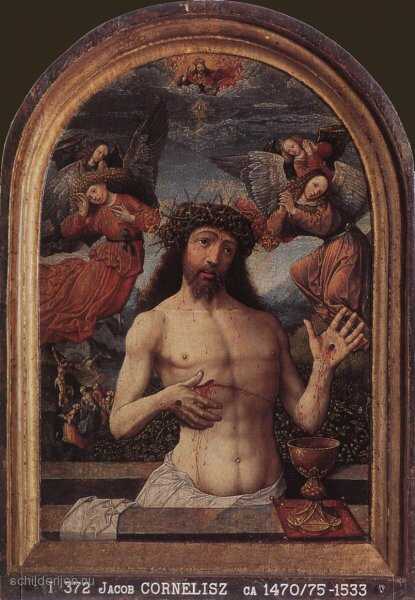A fifteenth-century legend tells how Pope Gregory the Great (540-604) discovered that one of the altar boys at a mass in Rome’s Santa Croce did not believe in the sanctity of the Eucharist. So he asked God for a sign to persuade the sceptic of Christ’s presence in the Eucharist and to save the poor boy’s Christian soul. His prayer was answered immediately. The crucified Christ appeared in a vision above the altar, surrounded by the implements of the Passion: the arma christi. The legend affirms the Catholic dogma which was ratified at the Lateran council of 1215: Christ is present in the consecrated bread and wine of the Eucharist in flesh and blood.
Artists of the late mediaeval period began exploring themes in greater depth, zooming in on their subject. They were less interested in peripheral elements that distracted from the work’s essence. Artists separated the Man of Sorrows theme from the general Gregorian mass depictions. An icon at Santa Croce showing the dead Christ is a good example. Christ appears with head bowed, hands crossed and the signs of the stigmata, in front of the cross. The traditional depiction of Christ surrounded by the arma christi also originated in the devotion at Santa Croce; it is in this church that the implements of the Crucifixion are preserved.
This icon was the source of inspiration for other depictions of the Man of Sorrows, which developed into two types. In one, Christ appears full-length, all five wounds of the stigmata are visible, and roundabout are the implements of the Passion. He may be standing by a sepulchre, in front of the cross; occasionally he appears seated on the side of the tomb. Christ generally only wears a loincloth and a crown of thorns. A halo may radiate about his head, in which case the crown of thorns is shown among the arma christi in the background. Sometimes he appears with his arms crossed over his chest; alternatively, his arms may be spread, to show the wounds of the nails that held his hands to the cross. In some pictures, the artist shows the gaping wound in his side. Here blood flows or spurts out, sometimes directly into a chalice to indicate the Eucharist. In the second type, Christ appears knee-length. Only three of the stigmata wounds are visible. This is the type that Jacob van Oostsanen chose.
In the imagination of mediaeval artists, Christ is held by his lamenting mother. Some show Mary accompanied by John the Baptist. In these pictures, it is Christ’s dead corpse which she holds, his eyes closed. In a few works, God the Father witnesses the scene from the clouds.
The Man of Sorrows was a perfect theme for private devotion. Hardly surprising then that Jacob received many commissions to depict Christ in his final moments. These pictures must have had an enormous impact in the credulous, religiously observant age in which Jacob lived. Which was precisely the desire of his influential, compassionate patrons.

